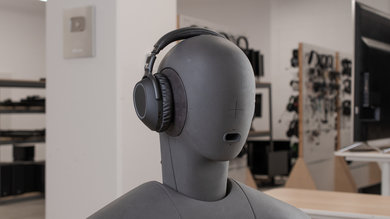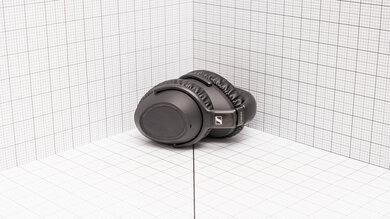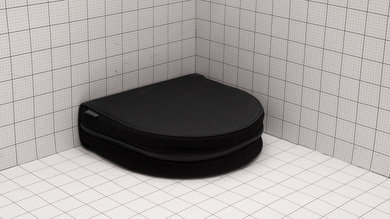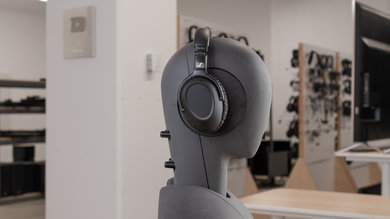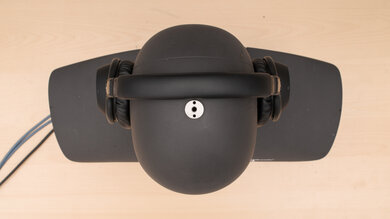The Sennheiser PXC 550-II Wireless are decent, well-rounded headphones. These premium-looking over-ears are very similar to their predecessor, the Sennheiser PXC 550 Wireless, and the most noticeable difference is their greatly improved ANC performance. Their sound profile is very well-balanced, and they should be versatile enough for most genres of music. Like the previous version, they have a comfortable and very stable fit, meaning they're even a good choice if you prefer using over-ear headphones at the gym.
Our Verdict
The Sennheiser PXC 550-II are decent for neutral sound. While their bass and mid ranges are excellently well-balanced, unfortunately, their treble isn't and may sound harsh or piercing. Due to their closed-back design, they also have a closed-off passive soundstage, and sound seems to come from inside your head. Overall, they're versatile and well-suited for most genres of music, but audiophiles may want to look elsewhere.
- Very accurate bass and mid-range performance.
- App has EQ presets.
- Closed-off passive soundstage.
- Uneven treble performance hurts overall audio reproduction.
The Sennheiser PXC 550-II are very good for commuting or travel. Thanks to their well-padded design, they're comfortable and can be worn for extended periods without fatigue or soreness. They also have a very good battery life, great for long flights. Their ANC performance is also great, and they do an effective job of blocking out the engine noise on a plane or bus. Unfortunately, they aren't the most portable, though they do fold flat and come with a soft carrying case to give them some protection.
- Great ANC performance.
- Very stable and comfortable fit.
- Somewhat bulky design.
The Sennheiser PXC 550-II are good over-ear headphones for sports use. They're comfortable and feel stable on the head, so they shouldn't move or fall off during jogs. They also breathe very well for over-ear headphones, so you shouldn't sweat more than usual, making them a very good choice if you prefer the fit of over-ears but want headphones that you can also take with you to the gym. Like most over-ear headphones, they lack an IP rating for dust or water resistance and can fall off during intense workouts.
- Very stable and comfortable fit.
- Premium look and feel.
- No IP rating for water resistance.
The Sennheiser PXC 550-II are good for office use. They're comfortable and have a very long battery life, meaning you should be able to use them for a full work day. Their ANC also does an excellent job of blocking out background chatter, helping you keep focused at work. Unfortunately, they do leak a bit of audio, though it likely won't be enough to bother those around you unless you work in an extremely quiet environment or blast your music.
The Sennheiser PXC 550-II aren't recommended for wireless gaming. They can only connect wirelessly via Bluetooth, meaning they won't be compatible with PS4 or Xbox One without a wired connection. While you can pair them to a Bluetooth-enabled PC, their somewhat high latency makes them less ideal for gaming unless your PC supports the aptX(LL) codec, which provides lower latency. They also have high latency with iOS, but it's lower with Android, so they're more suitable for mobile gaming on those devices.
The Sennheiser PXC 550-II are decent for wired gaming if you don't need mic support. They come with a 1/8" to 1/16" TRRS cable, but this only supports audio across PCs as well as Xbox and PlayStation consoles if you plug it into a controller. However, we could connect to both consoles with full mic and audio support by swapping the cable for another cable with an integrated mic. These headphones can also connect to PCs using their micro-USB to USB-A cable, and they have a low latency connection suitable for gaming.
- Very stable and comfortable fit.
- Uneven treble performance hurts overall audio reproduction.
The Sennheiser PXC 550-II are decent headphones for phone calls. Their microphone performance is decent, and speech transmitted with these headphones sounds better than many other Bluetooth headphones. Unfortunately, their noise handling isn't very good, and the person on the other end of the line will likely have a hard time hearing you if you're in a moderately noisy environment.
- Great ANC performance.
- Mic has decent noise handling.
- Uneven treble performance hurts overall audio reproduction.
Changelog
- Updated Nov 14, 2022: We've corrected our results for Xbox One and Xbox Series X|S Wired USB compatibility in Xbox Compatibility.
- Updated Jul 15, 2022: We've retested the 1/8" to 1/16" audio cable that was included in the box. Its connection only supports audio, so you won't have mic support. We have updated the text in the following tests: 'Wired', 'PC Compatibility', 'PlayStation Compatibility', and 'Xbox Compatibility'.
- Updated Jan 27, 2022: Updated review for accuracy and clarity.
- Updated Sep 08, 2021: Retested 'Wired | Analog/USB Audio Latency'.
Check Price
Differences Between Sizes And Variants
The Sennheiser PXC 550-II come in one variant with an all-black design. If you come across another variant, let us know in the discussions, and we'll update the review.
Popular Headphones Comparisons
The Sennheiser PXC 550-II are very similar to the previous version. They both look and feel the same, with the main improvement being their ANC performance, which is much better. They have a much more stable fit than the similar Sony WH-1000XM3 Wireless or Bose QuietComfort 35 II/QC35 II Wireless 2018, which makes them a great option if you like using over-ears at the gym.
See our recommendations for the best wireless Bluetooth headphones, the best noise cancelling headphones, and the best over-ear headphones.
The Sennheiser PXC 550-II Wireless are a minor upgrade over the Sennheiser PXC 550 Wireless. They have much better ANC performance and an easier-to-use control scheme. Other than that, they both look almost identical, have the same features, and have very similar sound profiles.
The Sennheiser PXC 550-II Wireless and the Sony WH-1000XM4 Wireless have different strengths, and you may prefer either one. The Sony headphones are more comfortable and better built, and their ANC system does a significantly better job blocking background noise. Their companion app also offers a graphic EQ and presets to help you adjust their sound to your liking. The Sennheiser headphones have a better overall performing integrated mic and a more stable and breathable fit.
The Sennheiser PXC 550-II Wireless are better headphones than the Bowers & Wilkins PX7 Wireless. They have better controls, a much more accurate sound profile, and feel more stable. On the other hand, the Bowers & Wilkins feel more premium, have much longer battery life, and very similar ANC performance.
The Sennheiser PXC 550-II Wireless are better than the Beats Solo Pro for most purposes. The Sennheiser are much more comfortable, stable, and portable. They can be used wirelessly or wired with the included 1/8" TRRS cable (although this connection only supports audio), and their mic has a much better overall performance. They support multi-device pairing and work with an app that has sound customization options. On the other hand, the Beats have a more neutral default sound profile, which some listeners may prefer. They also have longer continuous battery life and a much better build quality.
Test Results

The Sennheiser PXC 550-II are over-ear wireless headphones with a fairly sleek and understated style. They look identical to the Sennheiser PXC 550 Wireless, though they now only come in an all-black design with no silver accents. They're made with high-quality materials that give them a premium, high-end look.
The Sennheiser PXC 550-II Wireless are quite comfortable over-ears. They have the same great padding as the Sennheiser PXC 550 Wireless, with fairly small ear cups that should still be large enough to comfortably fit most people. Unfortunately, although the headband is heavily cushioned and comfortable, it doesn't extend very far, so these headphones may not fit all head sizes and shapes.
The Sennheiser PXC 550-II have a great control scheme. All of the controls are on the right ear cup, and they're intuitive and easy to use. There are also voice prompts for some functions, like when you mute or unmute the microphone, but none for track skipping or switching between ANC modes, which is slightly disappointing.
Right ear cup
Touch-sensitive surface:
- Single tap: Plays and pauses audio.
- Double tap: Cycles between transparency mode on and off. Also puts an active call on hold, and switches between an active call and a held call.
- Vertical swipe up: Increases the volume.
- Vertical swipe down: Decreases the volume.
- Ηorizontal swipe forward: Skips the track forward. Also unmutes mic during a call.
- Ηorizontal swipe forward and hold: Fast forwards the track.
- Ηorizontal swipe backwards: Skips the track backward. Also mutes the mic during a call.
- Ηorizontal swipe backward and hold: Rewinds the track.
- Ηold for 2 seconds: Rejects a call.
Voice assistant button:
- Single press: Activates voice assistant.
- Ηold for 4 seconds: Activates pairing mode.
ANC switch:
Switches between ANC on, ANC off, and a 'User mode' that you can set in the app.The Sennheiser PXC 550-II are passably portable. They take up some room in a bag, like most over-ear headphones, but you can fold them into a more compact shape to save space or swivel the ear cups flat, which makes it more comfortable to wear them around your neck.
The Sennheiser PXC 550-II's sound profile is bright and well-balanced and should be well-suited for most genres of music and content like podcasts and audiobooks. Unfortunately, our unit's left and right drivers have a mismatched frequency response in the treble range, which causes vocals to sound veiled or lacking in detail in the right driver. This may not affect every unit, however. Sibilants are also slightly harsh and piercing sibilants (S and T sounds) in both earbuds. The companion app has a few EQ presets you can use to adjust their sound, which is nice.
The Sennheiser PXC 550-II's frequency response consistency is decent. They're fairly consistent in the bass range, but their treble delivery is sensitive to the fit and positioning of these headphones on the head. This means that different people may experience their treble reproduction differently.
The Sennheiser PXC 550-II have excellent bass accuracy. Most of the response is neutral, so mixes have thump, rumble, and punch. There's some overemphasis in the high-bass range, which gives instruments extra boom.
The Sennheiser PXC 550-II's mid-range response is very accurate. The low-mid and mid-mid are very flat, meaning lead instruments should sound detailed and present. In high-mid, our right driver dips, which hurts the clarity of lead vocals and instruments a bit. However, vocals should still stay present and sound detailed overall.
The Sennheiser PXC 550-II's treble accuracy is decent. Vocals may lack a bit of detail, and sibilants like S and T sounds and cymbals may sound harsh and piercing.
Note: Our unit's L/R drivers are slightly mismatched in terms of frequency response, and the right driver's low-treble response is more underemphasized than the left driver's. This may be unique to our unit, however.
The Sennheiser PXC 550-II's peaks and dips performance is decent. The most noticeable peaks/dips are in the treble range, which unfortunately is quite uneven. The dips in low-treble, mostly present in our unit's right driver, result in some detail being lost from vocals, whereas the peaks in mid-treble cause cymbals and sibilants (S and T sounds) to sound harsh and piercing. There are peaks in the low-bass that add thump and rumble to mixes and a peak in the high-bass that adds boom.
The Sennheiser PXC 550-II's imaging performance is great. The group delay falls below the audibility threshold for almost the entire range, although it does cross it in low-bass, suggesting that the sub-bass may be a bit loose. It's audible but may not be noticeable to all listeners with regular content. Our unit's L/R drivers are also slightly mismatched in terms of frequency and phase response, which can cause inaccuracies in the stereo image, though this may be difficult to hear with regular content. It's worth noting that these results are only valid for our unit, and yours may perform differently.
The Sennheiser PXC 550-II have a poor soundstage. There's not much pinna activation, and the closed-back design sounds less open than open-back headphones. The soundstage sounds fairly small, unnatural, and as if inside the listener's head as opposed to in front.
The Sennheiser PXC 550-II's weighted harmonic distortion performance is good. All frequencies fall within acceptable limits, resulting in a clear and pure audio reproduction.
These are the settings used to test the Sennheiser PXC 550-II Wireless. Our results are only valid with these settings.
The Sennheiser PXC 550-II have a great noise isolation performance. Their ANC feature works much better than their predecessor, the Sennheiser PXC 550 Wireless. They do a good job of blocking the low rumble of plane and bus engines as well as ambient conversations and a decent job of reducing higher-pitched noise like a humming computer fan.
The Sennheiser PXC 550-II have an alright leakage performance. Not too much audio escapes, and most is in the treble range, meaning it sounds thin. Even at high volumes, your music shouldn't bother people nearby in a moderately noisy environment like an office.
The Sennheiser PXC 550-II have a mic with okay recording quality. Your voice sounds reasonably full and clear and shouldn't be too muffled.
The Sennheiser PXC 550-II's mic has decent noise handling. With moderate background noise, your voice sounds louder than the ambient sound and is easily understood. Even in noisier environments like a busy subway station, it does a satisfactory job of separating your voice from noise. However, it may be hard to understand you clearly if there's a loud noise present, like the sound of a passing train.
The Sennheiser PXC 550-II Wireless have an excellent battery performance. Their battery provides just over 21 hours of continuous use off a single charge, so you probably don't need to recharge them daily. They also recharge in less time than the advertised three hours. Ηowever, battery performance can vary with real-life use, so your experience may vary. There's also a 'Smart Pause' feature that pauses your music when you take off the headphones and puts them in standby mode after five minutes without a Βluetooth connection. This can help preserve battery life, but you can also switch it off in the app. If you run out of battery, you can also use the headphones passively with the provided audio cable. To turn off the headphones completely, you simply fold the ear cups flat.
The dedicated companion app for the Sennheiser PXC 550-II is okay. You can set the 'User mode' for the right earcup's ANC slider to either 'Adaptive ANC' (noise cancelling depending on your environment) or Anti-Wind (advertised as 'slight' noise isolation to reduce noise from wind or movement). Otherwise, there are only a few EQ presets and room effects, unlike the Sennheiser Momentum 3 Wireless which have a full parametric EQ. On the upside, it's available on both iOS and Android.
The Sennheiser PXC 550-II are Bluetooth headphones that support aptX-LL for low-latency connections. Their default latency with PCs is slightly high, but it's lower using the aptX-LL codec, so you shouldn't notice audio sync issues if your computer supports it. Their latency with Android devices is also low, but it's higher with iOS, so they aren't ideal for mobile gaming or watching videos on an iPhone. Some devices and apps seem to compensate for latency, though, meaning you may have a different experience. These headphones also support multi-device pairing, so you can watch a movie on your computer and answer your phone without having to re-pair them.
You can use the Sennheiser PXC 550-II wired with the included 1/8" to 1/16" TRRS cable if your device has a headphone port. They can only receive audio via this connection, so you won't be able to use their mic. If you want to use them wired with full compatibility, you'll need to use a different audio cable with an integrated mic.
These headphones also come with micro-USΒ to USΒ-A cable for charging. You can use this cable for audio and mic support, though. However, there's a drop in audio quality when you're using the mic at the same time. If you stop using the microphone, the audio quality returns to normal. Their negative latency result means you may hear the audio before the video when you're gaming or watching a movie, but the amount of latency is so small that this shouldn't be noticeable.
The Sennheiser PXC 550-II are fully compatible with PCs if you use their micro-USΒ to USΒ-A cable to connect. However, you'll only be able to receive audio if you're using their 1/8" TRRS to 1/16" TRRS cable, as this connection won't pass through mic audio.
The Sennheiser PXC 550-II are fully compatible with PlayStation consoles via a wired USΒ connection. We experienced issues using the 1/8" to 1/16" TRRS cable. We originally reported that the headphones enter 'Talk-Through' mode when connected via an analog to a PS4 console. We retested this with the same included 1/8" to 1/16" TRRS cable and didn't experience the same issue. However, this time the mic didn't work. It's normal, as this connection can only pass through audio, so you won't be able to use the mic. Using a different TRRS cable with an integrated mic, we could get full compatibility with PS4 and PS5 consoles without entering 'Talk-Through' mode.
Although we originally reported that you could connect these headphones to your Xbox console via USB, these headphones won't work via this connection. You can only receive audio via analog when plugged into your Xbox controller's AUX port, and you won't be able to use their mic.

